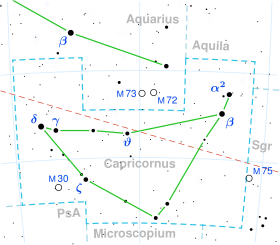| Observation data Epoch J2000.0 Equinox J2000.0 | |
|---|---|
| Constellation | Capricornus |
| Right ascension | 20h 21m 0.7s [citation needed] |
| Declination | 14° 46′ 53″ [citation needed] |
| Apparent magnitude (V) | +3.05/+6.09 [citation needed] |
| Characteristics | |
| Spectral type | K0II+B8V/A0III |
| U−B color index | 0.28/−0.11 |
| B−V color index | 0.79/−0.02 |
| Variable type | none |
| Astrometry | |
| Radial velocity (Rv) | −19/−18 km/s |
| Proper motion (μ) | RA: 48.42/42.64 mas/yr Dec.: 14.00/0.37 mas/yr |
| Parallax (π) | 8.3966 ± 0.6348 mas[1] |
| Distance | 390 ± 30 ly (119 ± 9 pc) |
| Absolute magnitude (MV) | −2.03/+1.03[2] |
| Other designations | |
| β1 Cap: BD−15° 5629, HD 193495, HIP 100345, HR 7776, WDS J20210-1447A | |
| β2 Cap: BD−15° 5626, HD 193452, HIP 100325, HR 7775, WDS J20210-1447B | |
| Database references | |
| SIMBAD | β Cap |
| β1 Cap | |
| β2 Cap | |
Beta Capricorni (β Capricorni, abbreviated Beta Cap, β Cap) is a multiple star system in the constellation of Capricornus and located 328 light-years from the Sun. Because it is near the ecliptic, Beta Capricorni can be occulted by the Moon,[3] and also (rarely) by planets.
The system is believed to consist of five stars.[4] With binoculars or a small telescope, Beta Capricorni can be resolved into a binary pair. The brighter of the two is designated Beta1 Capricorni or Beta Capricorni A; the dimmer, Beta2 Capricorni or Beta Capricorni B. Both are themselves made up of multiple stars. Beta1 Capricorni has three components; a single star designated Beta Capricorni Aa (formally named Dabih /ˈdeɪbiː/, the traditional name of the system)[5][6] and a binary pair, Beta Capricorni Ab (whose two components are designated Beta Capricorni Ab1 and Ab2). Beta2 Capricorni is also a binary pair, with components designated Beta Capricorni Ba and Bb.
Two other nearby stars were discovered by John Herschel. Sometimes referred to as Beta Capricorni D and E, it is unclear whether they are simply optical doubles or part of the Beta Capricorni system.[citation needed]
- ^ Brown, A. G. A.; et al. (Gaia collaboration) (2021). "Gaia Early Data Release 3: Summary of the contents and survey properties". Astronomy & Astrophysics. 649: A1. arXiv:2012.01533. Bibcode:2021A&A...649A...1G. doi:10.1051/0004-6361/202039657. S2CID 227254300. (Erratum: doi:10.1051/0004-6361/202039657e). Gaia EDR3 record for this source at VizieR.
- ^ Cite error: The named reference
Anderson2012was invoked but never defined (see the help page). - ^ Cite error: The named reference
White1987was invoked but never defined (see the help page). - ^ "Displaying next number in catalog HIP => 100345". Multiple Star Catalog. Archived from the original on 2018-07-26. Retrieved 2018-07-26.
- ^ Kunitzsch, Paul; Smart, Tim (2006). A Dictionary of Modern star Names: A Short Guide to 254 Star Names and Their Derivations (2nd rev. ed.). Cambridge, Massachusetts: Sky Pub. ISBN 978-1-931559-44-7.
- ^ "Naming Stars". IAU.org. Retrieved 18 June 2018.
